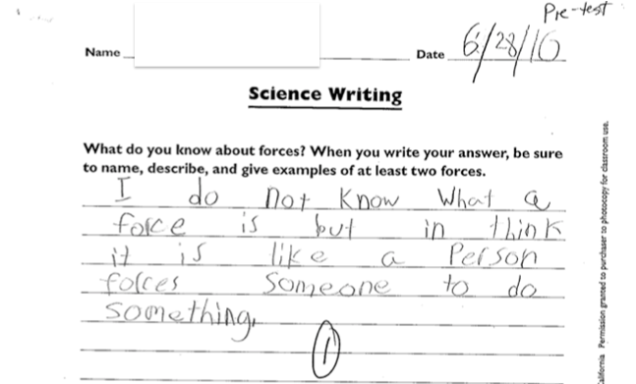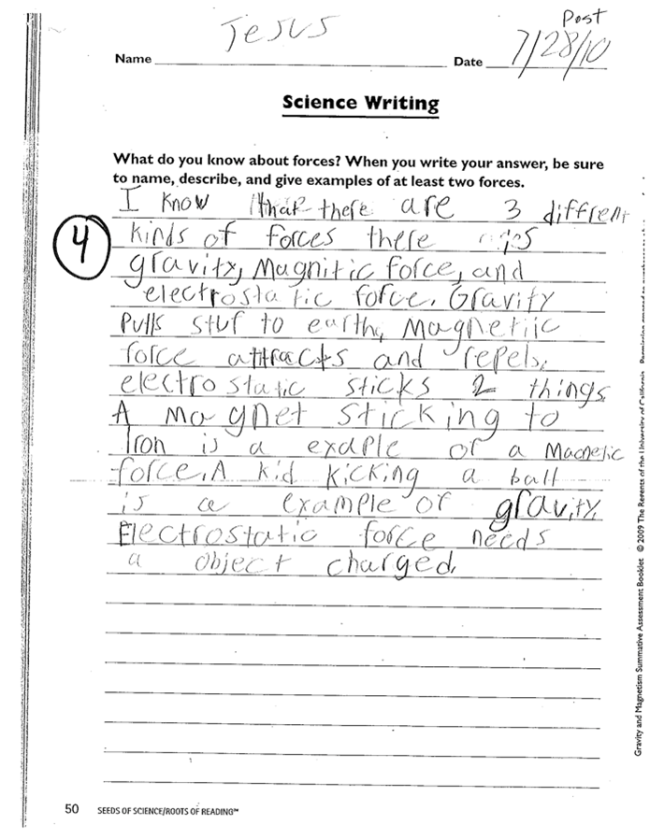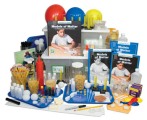Summer school can have a profound, positive effect on student learning. Minneapolis Public Schools use several of our Seeds of Science/Roots of Reading® units in their summer school program. They see the positive results: students actively engaged in learning both science content and literacy skills. Science can motivate and inspire reluctant readers to engage with texts the way scientists do, providing a purpose and context for reading and writing. When students read, write and communicate about something they’re interested and engaged in, they’re more likely to stick with it, work hard, and make gains; what literacy experts call the “productive struggle.”
Here’s an example of student work from a short pretest at the beginning of the summer school session:

You can see that this struggling reader/writer in grade 3 has an everyday understanding of the word force, not a scientific understanding.
After a four-week immersion in the Gravity and Magnetism unit from the Seeds of Science/Roots of Reading program, this young scientist developed a much more comprehensive understanding of force as a scientific concept:

We’re proud of the hard work these Minneapolis students (and their teachers) put in over the summer and the learning gains they made. This summer school implementation is inspiring more science-focused summer school programs across the country and we hope this immersion into the role of scientists encourages these students to choose STEM career paths!
June 23, 2014 at 2:02 pm
The loss of learning that can occur when kids do not engage in any educational activities in the summer months is known as the “summer slide.” While summer is the perfect time for students to relax, on average, students lose the equivalent of two months of math and reading skills during the summer months. Unequal access to summer learning opportunities[1] can explain more than half of the achievement gap between lower- and higher-income youth.
The best way to prevent students from sliding or becoming “rusty readers” is simply to get them reading! With that in mind, Madison Killen, a student at the University of California Berkeley and an intern in Department of ED’s Office of Communications and Outreach, offers five of the best ways to keep your child reading this summer:
- Let your child choose what they want to read — or have read to them — for 30 minutes each day. Children are much more likely to engage in material that interests them rather than materials forced on them.
- Use language and reading opportunities throughout the day. Talk often with your child and point out reading materials wherever possible: on menus, magazines and newspapers, signs, brochures, maps, guidebooks, smartphones, tablet computers, etc.
- Make daily reading a social event. Get the whole family to join in with their own books or take turns reading the same book aloud. Include telling stories as well.
- Connect reading to other summer events. If you take your child to the zoo, think about reading a book about animals before and afterward. This will place your child’s reading within a larger context.
- Make reading a lifestyle choice. Keep books all around the house to cultivate an atmosphere of reading, and set an example by reading yourself. Children need good models of reading books, magazines, or newspapers.
[1] http://www.ed.gov/blog/2013/06/seize-the-summer-keep-kids-active-engaged-in-learning/
June 6, 2014 at 5:08 pm





